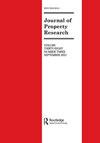改变主要零售宣传。城市中心零售市场空间适应性的GIS分析
IF 2.3
Q2 URBAN STUDIES
引用次数: 1
摘要
本文对爱丁堡、格拉斯哥、赫尔、利物浦和诺丁汉等主要零售区域内的零售物业的密度和位置进行了为期17年的调查。这项研究是新颖的,因为它开发了原始的空间数据库,并采用了独特的方法来探索英国北部城市的空间变化。本文从零售市场表现出适应性弹性的前提出发,零售集群的使用和变化会对扰乱市场聚集和竞争效应的内源性和外源性冲击做出反应。研究结果表明,重要的新零售主导的发展对城市内部的空间结果产生影响,影响主要和次要零售场所的规模和位置。在没有实质性供应中断的城市零售中心,社会经济环境的干扰可以在主要零售场所的外围边缘造成收缩。本研究对新发展、顾客购物习惯的改变和零售商选址偏好的变化的微观效应提供了一个历史视角。此外,该研究还开发了可复制和可靠的方法,可用于检查和监测城市中心的空间变化。了解这些动态的微观空间效应对未来城市中心的管理非常重要。本文章由计算机程序翻译,如有差异,请以英文原文为准。
Shifting prime retailing pitches. A GIS analysis of the spatial adaptations in city centre retail markets
ABSTRACT In this paper, the density and location of retail properties located within the primary retailing areas of Edinburgh, Glasgow, Hull, Liverpool and Nottingham are investigated over a 17 year period. The study is novel due to the original spatial databases developed and unique combination of established methods employed to explore spatial change within these northern UK cities. The paper starts from the premise that retailing markets display adaptive resilience where adaptations in use and variation in retail clustering will occur in response to endogenous and exogenous shocks that disturb the market’s agglomerative and competitive effects. The results suggest that significant new retail-led developments have intra-urban spatial outcomes that impact on the size and location of prime and secondary retailing pitches. In urban retailing centres where there have been no substantive supply disruptions, disturbances in the socio-economic environment can create contractions at the peripheral edges of the prime retailing pitch. This study is significant in providing a historical perspective of the micro-level effects of new development, changing customer shopping habits and shifting retailer location preferences. In addition, the research develops replicable and robust methods that can be employed to examine and monitor spatial change in urban centres. Understanding these dynamic micro-spatial effects are important for the future management of urban centres.
求助全文
通过发布文献求助,成功后即可免费获取论文全文。
去求助
来源期刊

Journal of Property Research
URBAN STUDIES-
CiteScore
3.80
自引率
5.30%
发文量
13
期刊介绍:
The Journal of Property Research is an international journal. The title reflects the expansion of research, particularly applied research, into property investment and development. The Journal of Property Research publishes papers in any area of real estate investment and development. These may be theoretical, empirical, case studies or critical literature surveys.
 求助内容:
求助内容: 应助结果提醒方式:
应助结果提醒方式:


